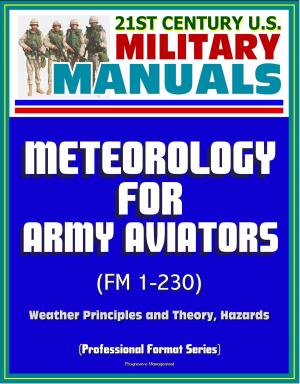21st Century U.S. Military Manuals: Weapons of Mass Destruction (WMD) Civil Support Team Operations - Field Manual 3-11.22 - Threats, Delivery Systems (Professional Format Series)
Nonfiction, History, Military, Biological & Chemical Warfare, Nuclear Warfare| Author: | Progressive Management | ISBN: | 9781301593224 |
| Publisher: | Progressive Management | Publication: | November 25, 2012 |
| Imprint: | Smashwords Edition | Language: | English |
| Author: | Progressive Management |
| ISBN: | 9781301593224 |
| Publisher: | Progressive Management |
| Publication: | November 25, 2012 |
| Imprint: | Smashwords Edition |
| Language: | English |
Professionally converted for accurate flowing-text e-book format reproduction, this Army Field Manual serves as the foundation for Weapons of Mass Destruction (WMD)-Civil Support Team (CST) doctrine and focuses on the organization, mission, command and control (C2), and operations of the WMD-CST. It discusses employment concepts, planning considerations, capabilities, and the type of support that WMD-CSTs can provide during a response. This information should be shared with key decision makers at local, state, and federal levels.
Chapter 1 * FUNDAMENTALS * Overview * Background * Operational Framework * Weapons of Mass Destruction-Civil Support Teams * Chapter 2 * COMMAND AND CONTROL * Response Management Plan and Concept of Operation * Command and Control Relationships * Transition to Title 10 United States Code or Title 32 United States Code Status * State-to-State Agreements * Other Command Relationships * Requests for Support and Assistance * State Management of Weapons of Mass Destruction-Civil Support Teams * Chapter 3 * THE THREAT * General * Specific Types of Threats * Delivery Systems * Recognizing a Terrorist Attack * Chapter 4 * MISSION, CAPABILITIES, LIMITATIONS, PHASES OF OPERATION, AND NONRESPONSE SUPPORT * Mission * Capabilities * Limitations * Phases of Operation * Nonresponse Support * Chapter 5 * INTEROPERABILITY * Overview * Interagency Operations * Joint Operations * Multiple Team Response Operations * Split-Unit Operations * Relief-in-Place Operations * Retrograde Operations * Chapter 6 * ASSESSMENT * Overview Process * High-Value Targets and Target Areas of Interest * End-State Products * Unit Assessment Program * Chapter 7 * LIAISON * Overview * Programs * Federal Agencies * State Level Emergency Management Agencies * Joint Force Headquarters-State * Next Higher Military Headquarters * Other Military Units * Emergency Responders * Medical and Scientific Communities * Chapter 8 * ALERT MANAGEMENT * Mission Request Validation * Unit Recall and Predeployment Planning * Movement Planning Guidance * Plans and Orders * Transit Timelines and Considerations for Movement * Rapid-Reaction Airlift for an Unplanned Event * Chapter 9 * TRAINING MANAGEMENT * Overview * Commanders and Training * Mission-Essential Task List Development * Training Plans * Individual Training * Collective Training * Sustainment Training * Leader Training and Development * Appendix A * LEGAL ISSUES * Appendix B * DECONTAMINATION * Appendix C * MODELING * Appendix D * COMMUNICATIONS SECTION * Appendix E * TROOP-LEADING PROCEDURES * Appendix F * ASSESSMENT * Appendix G * REPORTS * Appendix H * UNIQUE SITUATIONS * Appendix I * SYMBOLOGY * Appendix J * MEDICAL AND ANALYTICAL
As a bonus, this reproduction includes the complete 2012 Army Leadership manual (FM 6-22), which describes the Army's view of leadership, outlines the levels of leadership (direct, organizational, and strategic), and describes the attributes and core leader competencies across all levels. The principal audience for ADRP 6-22 is all leaders, military and civilian. Trainers and educators throughout the Army will also use this publication.
Professionally converted for accurate flowing-text e-book format reproduction, this Army Field Manual serves as the foundation for Weapons of Mass Destruction (WMD)-Civil Support Team (CST) doctrine and focuses on the organization, mission, command and control (C2), and operations of the WMD-CST. It discusses employment concepts, planning considerations, capabilities, and the type of support that WMD-CSTs can provide during a response. This information should be shared with key decision makers at local, state, and federal levels.
Chapter 1 * FUNDAMENTALS * Overview * Background * Operational Framework * Weapons of Mass Destruction-Civil Support Teams * Chapter 2 * COMMAND AND CONTROL * Response Management Plan and Concept of Operation * Command and Control Relationships * Transition to Title 10 United States Code or Title 32 United States Code Status * State-to-State Agreements * Other Command Relationships * Requests for Support and Assistance * State Management of Weapons of Mass Destruction-Civil Support Teams * Chapter 3 * THE THREAT * General * Specific Types of Threats * Delivery Systems * Recognizing a Terrorist Attack * Chapter 4 * MISSION, CAPABILITIES, LIMITATIONS, PHASES OF OPERATION, AND NONRESPONSE SUPPORT * Mission * Capabilities * Limitations * Phases of Operation * Nonresponse Support * Chapter 5 * INTEROPERABILITY * Overview * Interagency Operations * Joint Operations * Multiple Team Response Operations * Split-Unit Operations * Relief-in-Place Operations * Retrograde Operations * Chapter 6 * ASSESSMENT * Overview Process * High-Value Targets and Target Areas of Interest * End-State Products * Unit Assessment Program * Chapter 7 * LIAISON * Overview * Programs * Federal Agencies * State Level Emergency Management Agencies * Joint Force Headquarters-State * Next Higher Military Headquarters * Other Military Units * Emergency Responders * Medical and Scientific Communities * Chapter 8 * ALERT MANAGEMENT * Mission Request Validation * Unit Recall and Predeployment Planning * Movement Planning Guidance * Plans and Orders * Transit Timelines and Considerations for Movement * Rapid-Reaction Airlift for an Unplanned Event * Chapter 9 * TRAINING MANAGEMENT * Overview * Commanders and Training * Mission-Essential Task List Development * Training Plans * Individual Training * Collective Training * Sustainment Training * Leader Training and Development * Appendix A * LEGAL ISSUES * Appendix B * DECONTAMINATION * Appendix C * MODELING * Appendix D * COMMUNICATIONS SECTION * Appendix E * TROOP-LEADING PROCEDURES * Appendix F * ASSESSMENT * Appendix G * REPORTS * Appendix H * UNIQUE SITUATIONS * Appendix I * SYMBOLOGY * Appendix J * MEDICAL AND ANALYTICAL
As a bonus, this reproduction includes the complete 2012 Army Leadership manual (FM 6-22), which describes the Army's view of leadership, outlines the levels of leadership (direct, organizational, and strategic), and describes the attributes and core leader competencies across all levels. The principal audience for ADRP 6-22 is all leaders, military and civilian. Trainers and educators throughout the Army will also use this publication.















